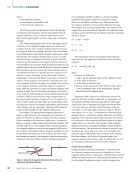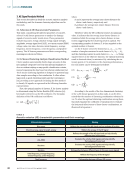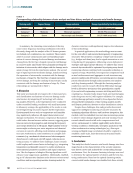distributed at the discontinuity boundary, which increases the
magnetic field strength in this region and ultimately enhances
the amplitude of the collected magnetic leakage signal.
To illustrate the transition of the axial signal from a single
to a double crest, we take a right-angled trapezoidal discon-
tinuity with an edge angle of 63° as an example, keeping the
other parameters unchanged. By varying the width of the dis-
continuity and the magnitude of the magnetizing current, we
obtain the graphs shown in Figures 5e and 5f. A comparative
study of Figures 5e and 5d reveals that the effects of varying
the discontinuity width and the discontinuity edge angle on
the axial signals are similar, both leading to a change in the
number of wave crests.
The specific reason is that an increase in the discontinuity
width leads to a significant increase in the dispersion of the
magnetic field lines at the discontinuity edge (Li et al. 2017).
When the magnetic field lines pass through discontinuities
with larger widths, there is a significant scattering effect at the
discontinuity edges, leading to increased bending and reflec-
tion of the magnetic field lines, which generates multiple wave
peaks in the magnetic leakage signal. On the other hand, as
the edge angle of the discontinuity increases, the distribution
of the magnetic field lines on both sides of the discontinu-
ity changes (Feng et al. 2022), and a stronger magnetic field
gradient is generated in the discontinuity region. When the
magnetic field gradient is concentrated in a certain region,
the detection signal will show a single peak characteristic. In
the center region of the discontinuity, the signal strength is
weakened due to the highly dispersed magnetic field lines,
resulting in a divergent distribution. This change in distribu-
tion pattern eventually leads to a shift in the axial signal from a
single to a double peak.
By analyzing the changes in radial and axial signals, the
morphological dimensions of the discontinuity and the size of
its edge angle can be evaluated.
Simulation and Analysis of Magnetic Leakage Signal for
Inner and Outer Discontinuities
All of the above studies have explored the relationship between
the edge angle of unilateral discontinuities and the variation
of the magnetic leakage signal. However, the effect of edge
angle changes on the magnetic leakage signal on both sides of
the inside and outside of the sample still needs to be further
investigated.
ME
|
MAGNETICLEAKAGE
60
70
80
40
30
20
50
10
–20
–30
–10
–40
–50
–60
–70
–80
0
0 5 10
Scanning path (mm)
15 20
60
70
80
90
100
110
120
130
140
40
50
0 5 10
Scanning path (mm)
60
65
70
75
80
8.15
8.10
8.05
8.00
7.95
7.90
55
45° 63° 34°
Edge angle (degrees)
15 20
63°
45°
34°
63°
45°
34°
63° 45° 34°
Figure 6. Inner and outer discontinuities and their magnetic leakage signal distributions: (a) model of the inner and outer discontinuities
(b) trend plot (c) radial signal component (d) axial signal component.
36
M AT E R I A L S E V A L U AT I O N • M AY 2 0 2 5
B
(mT)
B
(mT)
B
(mT)
L
t on
po
i
magnetic field strength in this region and ultimately enhances
the amplitude of the collected magnetic leakage signal.
To illustrate the transition of the axial signal from a single
to a double crest, we take a right-angled trapezoidal discon-
tinuity with an edge angle of 63° as an example, keeping the
other parameters unchanged. By varying the width of the dis-
continuity and the magnitude of the magnetizing current, we
obtain the graphs shown in Figures 5e and 5f. A comparative
study of Figures 5e and 5d reveals that the effects of varying
the discontinuity width and the discontinuity edge angle on
the axial signals are similar, both leading to a change in the
number of wave crests.
The specific reason is that an increase in the discontinuity
width leads to a significant increase in the dispersion of the
magnetic field lines at the discontinuity edge (Li et al. 2017).
When the magnetic field lines pass through discontinuities
with larger widths, there is a significant scattering effect at the
discontinuity edges, leading to increased bending and reflec-
tion of the magnetic field lines, which generates multiple wave
peaks in the magnetic leakage signal. On the other hand, as
the edge angle of the discontinuity increases, the distribution
of the magnetic field lines on both sides of the discontinu-
ity changes (Feng et al. 2022), and a stronger magnetic field
gradient is generated in the discontinuity region. When the
magnetic field gradient is concentrated in a certain region,
the detection signal will show a single peak characteristic. In
the center region of the discontinuity, the signal strength is
weakened due to the highly dispersed magnetic field lines,
resulting in a divergent distribution. This change in distribu-
tion pattern eventually leads to a shift in the axial signal from a
single to a double peak.
By analyzing the changes in radial and axial signals, the
morphological dimensions of the discontinuity and the size of
its edge angle can be evaluated.
Simulation and Analysis of Magnetic Leakage Signal for
Inner and Outer Discontinuities
All of the above studies have explored the relationship between
the edge angle of unilateral discontinuities and the variation
of the magnetic leakage signal. However, the effect of edge
angle changes on the magnetic leakage signal on both sides of
the inside and outside of the sample still needs to be further
investigated.
ME
|
MAGNETICLEAKAGE
60
70
80
40
30
20
50
10
–20
–30
–10
–40
–50
–60
–70
–80
0
0 5 10
Scanning path (mm)
15 20
60
70
80
90
100
110
120
130
140
40
50
0 5 10
Scanning path (mm)
60
65
70
75
80
8.15
8.10
8.05
8.00
7.95
7.90
55
45° 63° 34°
Edge angle (degrees)
15 20
63°
45°
34°
63°
45°
34°
63° 45° 34°
Figure 6. Inner and outer discontinuities and their magnetic leakage signal distributions: (a) model of the inner and outer discontinuities
(b) trend plot (c) radial signal component (d) axial signal component.
36
M AT E R I A L S E V A L U AT I O N • M AY 2 0 2 5
B
(mT)
B
(mT)
B
(mT)
L
t on
po
i













































































